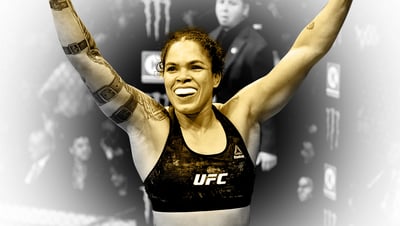
Issue 129
June 2015
Groundbreaking research has opened the door for revolutionary new approaches to safeguard fighters’ brain health. Fighters Only scans the world of neuroscience to find out how MMA athletes will be protected from brain injuries.
In the not-too-distant future, the career prospects of mixed martial artists may rest on the outcome of a simple mouth swab, blood test or MRI scan. Recent breakthroughs in the study of the human nervous system mean the identification of brain injuries could soon be both quick and affordable.
Advancements in the study and diagnosis of the effects of trauma on the human brain are destined to make a huge impact across the sports world. Doctors will be capable of answering the biggest question of all: is this athlete’s brain capable of undertaking a career in professional contact sports?
The career of a prizefighter is a short one. In fact, the years of high-level competition enjoyed by the majority of professional athletes rarely gets into double digits. Whether it’s MMA or boxing, football or hockey, the effects on the human body by far supersede any level of talent or determination.
And the biggest threat to all contact sports is that of brain injury, which is why the effects of taking blows to the head is a red-hot topic across the professional landscape today.
The exact effects of the cumulative blows endured over an athlete’s career are largely a mystery. But researchers are on the cusp of finding some very big answers to this age-old conundrum.
Recent breakthroughs in the research of brain trauma in sports – some directly involving many of the world’s leading mixed martial artists – may soon prove to be a game-changer in terms of athlete participation. And that will be felt nowhere more than inside MMA’s rings and cages.
UFC president Dana White is fascinated by the subject and excited as anybody in the sport about the brain trauma health breakthroughs currently being investigated across the US.

After spending his life around fighters, the subject has left him – like so many others – with far more questions than answers. He’s thrilled by the prospect of both learning and perhaps using all the findings to improve the safety and well-being of fighters in the UFC and beyond.
“Obviously, you can diagnose broken bones and stuff like that, but if you can figure out the brain side of this thing then that’s just such a home run for combat sports,” White explains in an exclusive interview with Fighters Only.
“When I was involved in boxing you saw guys who didn’t take any more damage than anybody else, yet they would develop problems with the brain. Then there were these other guys that were in wars and yet they’re functioning fine.
“For example, look at the wars Joe Frazier was in during his career. Yet before Joe Frazier passed away, just a couple of months before, I met him in Vegas. We had a completely normal conversation, yet Muhammad Ali has Parkinson’s. And those two were battling all the same guys at the same time.
“Jake LaMotta too. He’s still alive. ‘The Raging Bull’ is still switched on completely, touring the world talking to fans, and that’s a guy who went to war with Sugar Ray Robinson wearing horsehair gloves. The wars they had back in those days were no joke. And yet he’s still alive and still got it together.”
In boxing at least, for every handful of fully functioning former champions there’s at least one icon whose post-fight life has been tragically curtailed or inhibited as a direct result of their pugilistic efforts. The rapid declines of both Ali and Robinson, two of the sweet science’s greatest performers, cuts fans deep.
Both Alzheimer’s and Parkinson’s are degenerative neurological diseases directly associated with sporting careers involving head trauma. All too often, they’re diagnosed long after the damage is done.
And life-altering subconcussive trauma doesn’t just happen under the bright lights in front of thousands of fans either. It’s the accumulation of shots endured in the gym during fight camps where problems undoubtedly begin.
Professional fighters simply must take full-blown strikes to the head, certainly in the formative stages of their careers, in order to program themselves to perform under duress. But medical professionals now insist the level of trauma a person can sustain may vary substantially depending on the individual and his genetic makeup.
Neurologists are seeking relationships between risk factors for cognitive decline and evidence of brain dysfunction. They’re trying to understand why fighters with similar exposure are affected differently. Why do some experience a decline in brain health, yet others don’t?

Study 1: Neurocognitive decline
Since April 2011, the Cleveland Clinic Lou Ruvo Center for Brain Health in Las Vegas, Nevada has been developing a groundbreaking Professional Fighters Brain Health Study. Its goal is to identify early neurocognitive decline to predict any long-term neurological consequences.
This first-of-its-kind study measures the cumulative effects of head trauma during a fighter’s career. Routinely measuring athletes using computerized memory tasking and advanced brain scanning, its initial report is due to be published early next year.
Both the UFC and Bellator MMA – along with Glory kickboxing and boxing powerhouse promotions Golden Boy and Top Rank – are committed to the study. Active fighters from all five organizations and beyond have taken part for the past three years. They have tested about 500 individual subjects already. And it’s hoped more than 600 will have taken part by the end of the fifth year.
Speaking at a press event last year, UFC chairman Lorenzo Fertitta said: “Nothing is more important to the UFC than the health and safety of our athletes. As the world’s premier MMA organization, we have consistently lived up to that commitment to our fighters and we always will.
“(The UFC’s involvement) is a no-brainer for us as we continue our commitment to athlete safety. We are proud to join with these other prominent promoters – our colleagues and competitors – to support the Cleveland Clinic’s brain health study.
“We are encouraged by the early results of the study and we look forward to the final findings of the Lou Ruvo Center’s research, knowing that they will benefit our athletes, as well as athletes from many other sports.”
Early indications coming out of the Nevada clinic also suggest a huge breakthrough in the accountability of brain trauma victims. Neurologists involved are investigating findings that indicate a hereditary genome may well carry a susceptibility to head trauma.
If confirmed, this would literally mean some people are genetically capable of competing in fight sports, while diagnosed carriers of the gene would run a high risk of suffering from the prolonged effects of blows to the head.
Dana White offered FO a little more insight into the study’s progress during the recent UFC 189 World Tour press event. “Yeah, we’ve been doing a study with the Cleveland Clinic in Las Vegas for years now,” he says. “We’ve been helping to fund this study for so long and it’s fascinating stuff and hugely important to us.
“You know like how some people are susceptible to cancer and some are susceptible to other diseases? Well they’re starting to think we have a gene inside our body which means people are susceptible to brain damage, should they suffer repeated blows to the head.
“If that’s true – and we can one day test for that gene and find out who should stay away from contact sports, even soccer, American football and obviously contact sports – well, that’s incredible.”
Jon Jones, Glover Teixeira and Bellator’s Michael Chandler were all present at the launch of the study, indicating their likely participation. While TUF 9 winner Ross Pearson also told FO he’s a part of the program and he’s honored to be involved.
“Last year, the UFC sent a bunch of fighters to get brain scans,” he explains. “I did that last year in Vegas, got the scans and everything came back fine. They’re going to monitor our brains over the course of our fighting careers. It’s a pretty big thing.
“I believe it’s important you get those things checked up for fighters because if we keep going the way we’re going... I know I don’t wear head guards when I spar and I get hit all the time. But I don’t want to be blowing bubbles by the time I’m 45, you know what I mean?”
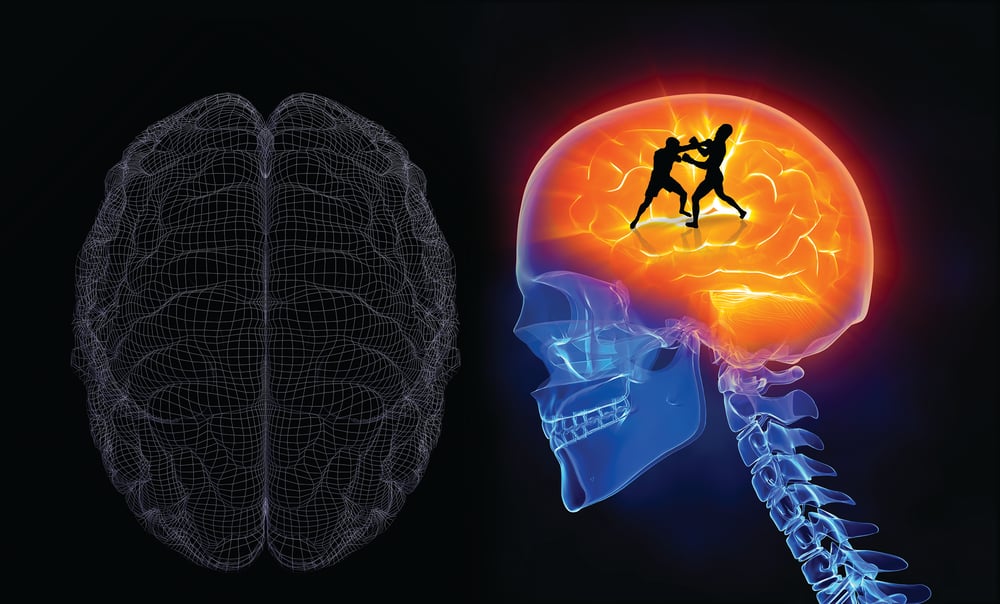
Study 2: Dementia pugilistica
Researchers at the University of California, Los Angeles (UCLA) have focused their
study specifically on chronic traumatic encephalopathy (CTE); more commonly known as dementia pugilistica or punch-drunk syndrome.
Until recently, CTE could only be detected by autopsy, when doctors examined slices of the brain of a deceased patient under a microscope. But the team at UCLA believes it has now discovered a way to scan and diagnose the brain-wasting disease in live patients.
Naturally, the findings of these studies could be monumental for MMA’s future. White agrees brain health is key to securing the long-term quality of life for today’s stars of the Octagon.
“If the findings at UCLA are true and this scan becomes available, then awesome,” he tells FO. “Absolutely that’s something we’d be interested in looking into.”
Being able to definitively determine whether a person is either genetically susceptible or is showing any effects of previous head trauma is crucial. It could decide whether that person receives a green light to compete safely in combat sports.
The neurosurgeon at the center of the UCLA study is Dr Julian Bailes. He believes in terms of fight sports the breakthrough is indeed “a game-changer.”
“This is the holy grail of CTE, to make the diagnosis in living people,” Bailes explains. “It’s an intriguing test, but it’s not for everyone. People are different. Some people say, ‘Why do I want to know I have CTE if there is no cure?’
“But maybe, if they’re an active pro athlete, it may be helpful for a retirement decision. It’s a little bit like genetic testing for some diseases. If you’re a woman, do you want to know if you have the gene for breast cancer?”
The long-term effects of a professional fighting career are of massive concern for MMA athletes. The sport’s leading organizations have been proactive in their support for athletes’ long-term health. The last thing anyone wants is the kind of attention the NFL and NHL have had in terms of former athletes suing for punitive damages as a result of head trauma-related illnesses in retirement.
Pro football and hockey has been hit with numerous cases in recent years. US government data that was released last year revealed the brains of 76 of 79 former NFL players had evidence of CTE. Researchers have also found CTE in the brains of former NHL players.
That doctors may now be able to diagnose patients including professional athletes and war veterans, and inform them while they’re alive that they have CTE, would be an incredible medical advance.
“It gets old to diagnose a disease after someone’s dead – you can’t intervene or help them,” adds Bailes, whose research team first detected CTE in the brain of deceased NFL legend Mike Webster in 2004.
“It wasn’t much fun after a while. When you’re diagnosing after death, you can’t follow the disease with studies over a period of time. You can’t develop treatment or drugs over a period of time. So three years ago, we set aside money for research and worked on a technique at UCLA where we used a special positron emission tomography scan to detect tau protein, which is associated with CTE.” Bailes says he’s on the verge of publishing a study of 20 subjects – including former Dallas Cowboys star running back Tony Dorsett, Buffalo Bills offensive lineman Joe DeLamielleure and former New York Giants defensive end Leonard Marshall – that confirms how CTE can be diagnosed successfully in living patients, before rolling it out commercially.

Safety first
Quite how rapidly these breakthroughs in neuroscience are able to have an impact on contact sports is yet to be seen. But with overwhelming pressure from both the NFL and NHL already to ensure athletes’ long-term mental health – along with growing unrest in fight sports – executives and officials from all over will be keen to move on the findings.
To think that existing athletes could be scanned accurately and regularly for signs of brain trauma is huge. Simply building a scan of that nature into any contract renewal or annual medical examination would be pretty straightforward – but perhaps expensive.
The costs estimated for the UCLA scan are about $10,000 per athlete, which certainly isn’t cheap and is about ten times more than the cost of the MRI and MRA brain scans currently used in annual medicals.
The genome science coming out of Nevada that’s got Dana White so excited sounds much more affordable. And to know if you have a brain that’s physiologically capable of taking blows to the head before you even start a professional fighting career would be incredible.
For now, however, MMA waits with bated breath for the science to make its way out of the lab to be accessible to all. But one thing’s for sure, the sweet sciences of the ring and the Octagon are about to be revolutionized.
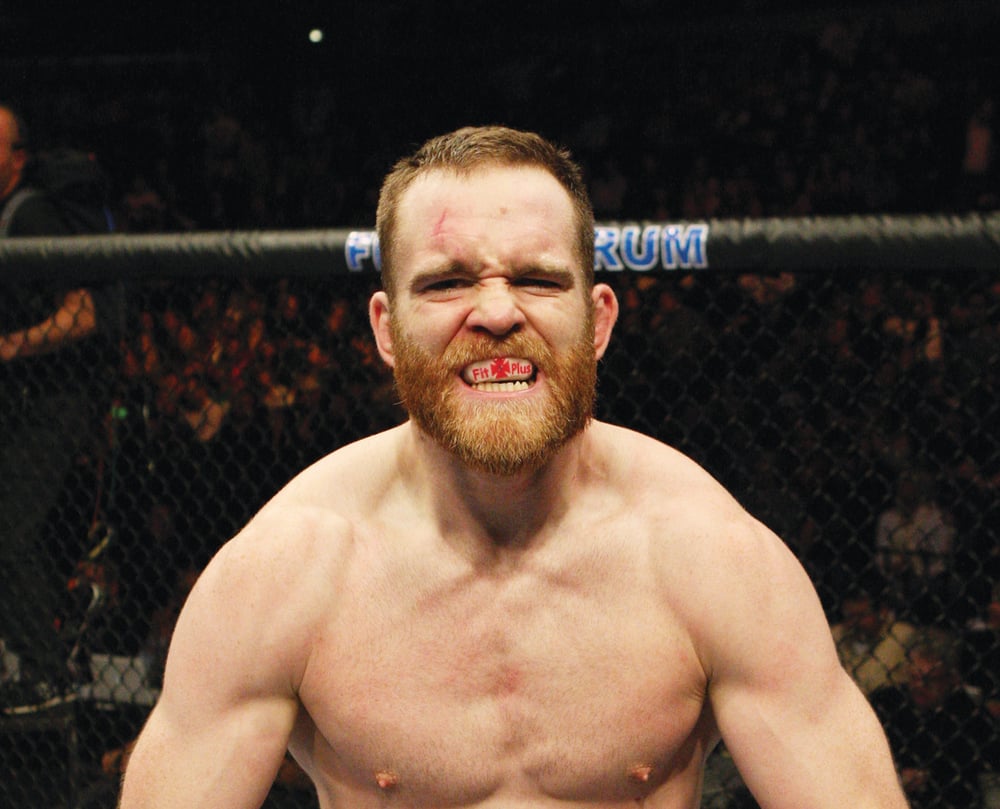
MMA case study 1: TJ Grant
Undoubtedly the biggest what-could-have-been story in recent MMA history. The 31-year-old lightweight could have been UFC champion by now,
but instead has spent two years on the sidelines. A definitive diagnosis of his ailments could offer him a career lifeline.
Grant booked a 155lb title shot against Benson Henderson when he capped a 5-0 win streak with a stunning first-round knockout of Gray Maynard in his last fight back in May 2013. But a concussion suffered during jiu-jitsu practice denied him the opportunity every fighter dreams of.
A date with Anthony Pettis was then nixed as he battled with his recovery. The full extent of the damage to his brain remains unclear, so his stint on the sidelines continues.
“I could fight tomorrow – I just know it wouldn’t be good for my long-term health,” Grant said in October. “Physically, I can do everything I need to, it’s just my brain. I want to make sure that’s OK, because it’s a lot more important than the other stuff. I know I can fight. I just want to be smart about it.
“I can work out at high intensity, I just don’t spar and stuff like that. We’ll see what happens. I’m just doing what I can and not getting too far away from the sport. Still somehow stay involved in it, watch it and keep my body in good shape. That’s really all I can do.”
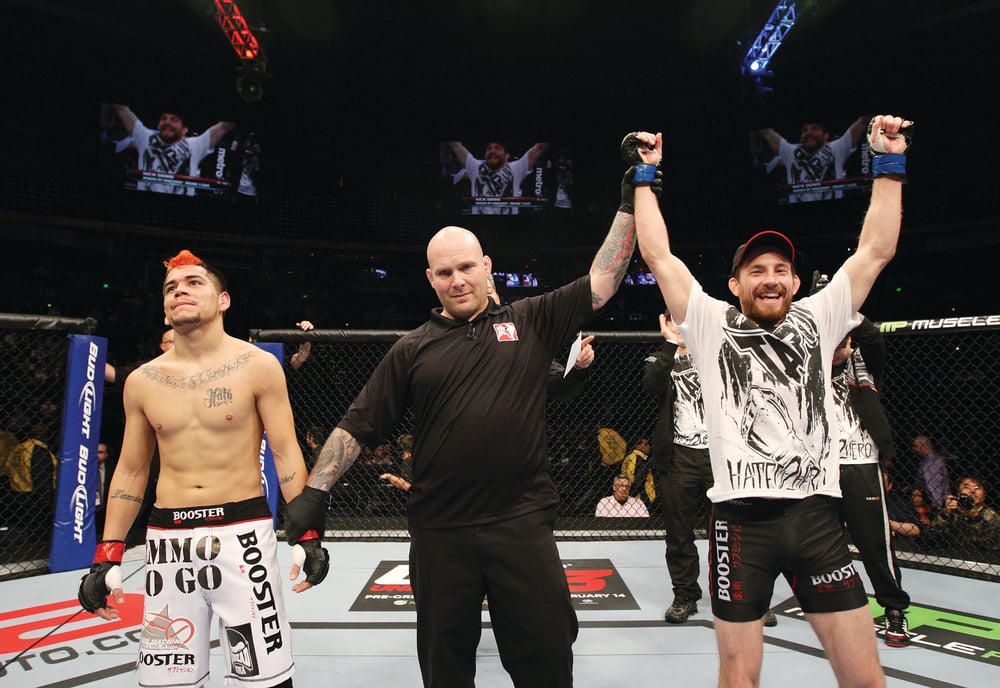
MMA case study 2: Nick Denis
‘The Ninja of Love’ had a promising MMA career, but walked away from it all with a 11-3 record at the age of 29 in 2012 because of his concerns about brain injuries.
The Canadian former Ph.D. student in biochemistry began to research concussions following a KO loss to Marlon Sandro in 2009 and discovered the dangers of subconcussive trauma – the blows to the head that don’t lead to a concussion.
He found that this damage accumulates, with shocking results. Research showed scans that revealed the brain morphology of men who never had an actual concussion, only subconcussive trauma, was decayed like individuals with later stages of neurodegenerative disorders.
“In the last couple of years… While sparring I would notice that when I got hit, it would affect me more and more,” he wrote in a blog post that announced his retirement.
“Maybe I have already suffered brain injury, maybe I never would have. That is the problem with the brain. You can’t really see the injury, it will take years and decades to manifest itself. When you get rocked in sparring, you shake your head and regain your composure, and within 10 seconds say, ‘OK, I’m good let’s keep going.’
“But are you actually OK? You are no longer dizzy, true, but do you have any idea what physical trauma your brain has just experienced?”
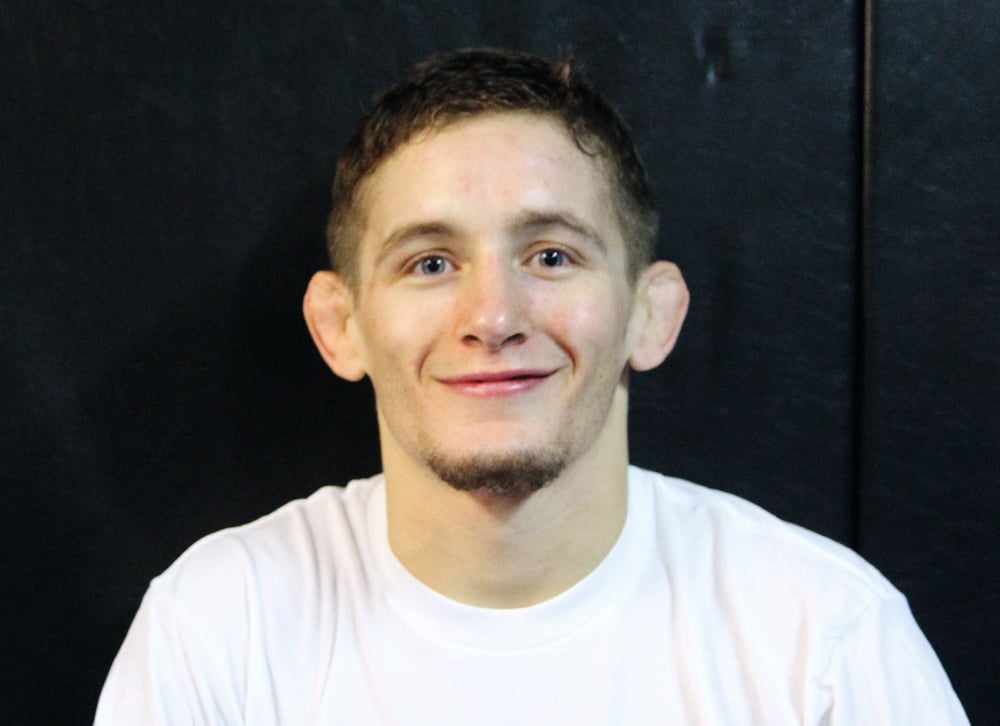
MMA case study 3: Chris Holdsworth
The lack of accurate brain trauma testing readily available right now has
left TUF 18 winner Chris Holdsworth putting his career on hold indefinitely.
The 27-year-old Team Alpha Male standout suffered consecutive fight camp concussions while preparing for his TUF tournament finale against Davey Grant in November 2013, and during preparations for his next outing against Chico Camus in May 2014. He’s been inactive ever since.
“I rushed back into things after the finale. I should have taken some more time off. I just didn’t know any better. I was feeling good. I felt 100%, but realistically I still had trauma. I still needed to heal up,” Holdsworth said.
“I definitely think people rush back from injuries and rush back from head trauma in general. These things take a lot longer than people think and everyone is like, ‘When are we gonna see you back?’ It’s like, man, when I’m healthy to fight. My health is more important than anything else.
“As I’m getting older, I’m starting to learn that it’s better to train smarter than harder. We don’t get paid in the gym; we get paid to fight. You’ve gotta conserve your body and most importantly conserve your brain.”
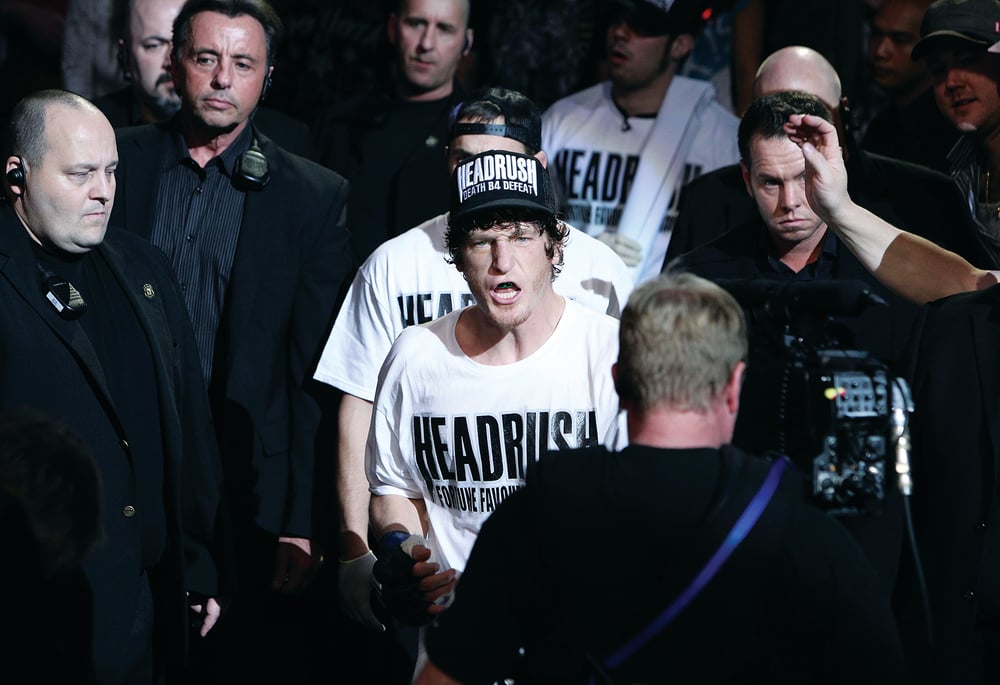
MMA case study 4: Mac Danzig
Mac Danzig took matters into his own hands 12 months ago when he signed off on his 21-12-1 career. A fear of “Alzheimer’s, Parkinson’s or dementia” were behind his reasons to hang them up.
After becoming a father, the TUF 6 winner believed concussions and brain trauma was beginning to effect him and his performances. After his third consecutive defeat, enough was enough.
He said: “The only physical cue for me to step back from competition came last year, when I began to suffer repeated concussions in training, leading up to what would end up being my first ever actual knockout loss, in July.
“After that, my ability to take hard strikes in training without losing consciousness began to deteriorate rapidly.
“After 14 years of training and taking shots like a champ, my brain was finally telling me to chill out. I was never the type of fighter to ‘train stupid,’ but sparring was always something I partook in at full throttle.
“I truly feel that the damage was done in the gym over the past decade, and hundreds of hard sparring sessions have accumulated, leading me to the situation I find myself in now.”
x4: Neurologists say once a person suffers a concussion they are as much as four times as likely to sustain a second one.
21%: According to the American Association of Neurosurgeons, 21% of all traumatic brain injuries in the US are related to sports and recreational activities.
1.6-3.8 million: The estimated number of sports-related traumatic brain injuries (TBIs) or concussions that occur in the US each year, according to the Brain Trauma Foundation.
...



